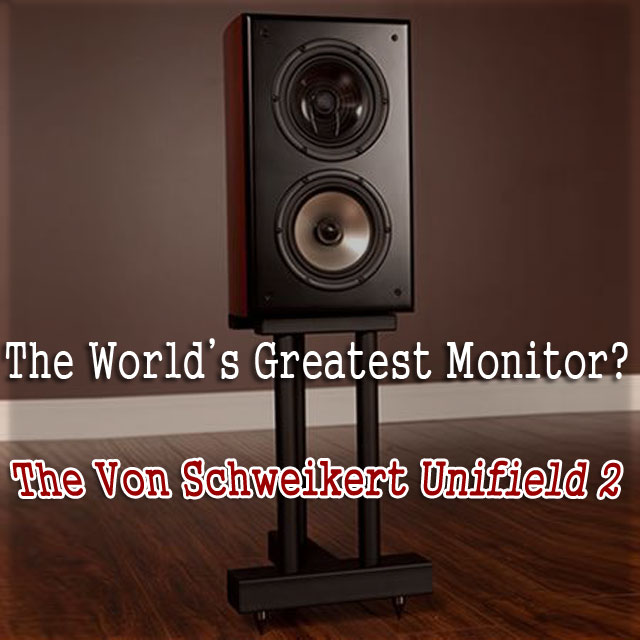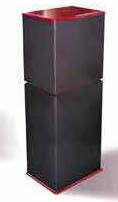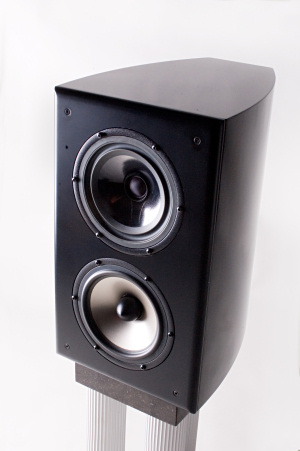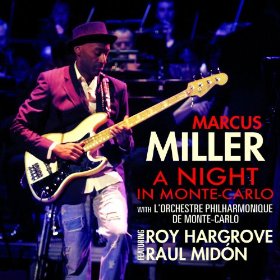Von Schweikert Audio UniField Model Two MkII loudspeaker



We’ve all heard tales of bookshelf or monitor-sized speakers that claim to have the sound of a larger speaker, but we all knew it’s pure hype – until the legendary engineer Albert Von Schweikert wrapped his mind around the engineering problems. Yes, this speaker system really does sound like a large tower – but wait, I won’t spoil the outcome, just keep reading.
 When I first met Albert Von Schweikert in the mid 1990’s, I had reviewed, then purchased, the speaker that made him a legend – the venerable VR-4, which I still am amazed at for what you got for a $3500 a pair (the VR-4 made Audio Review’s Best Twenty-Five Speakers of All Time list two years ago). Those original VR-4’s were huge and their modest asking price made them a “best buy” as they went down to 16Hz and had the most amazing soundstage I or anyone else had ever heard back then. If I recall correctly, two magazines had compared the VR-4 directly against the 5-times more expensive Wilson Watt Puppy and found the VR-4 to be the better speaker. I kid you not! A few years later I made a switch to his more expensive and elegant VR-6, which became a cult item with the SET crowd, as the VR-6 had a 94 dB sensitivity rating and was designed for low powered amplifiers. For several years, I basked in their beautiful sound: a sound with amazing detail combined with musical richness. It was rare to find a detailed loudspeaker that wasn’t analytical, but you know how it goes, audiophiles have to have the latest thing, so I moved on seeking to quench a certain thirst, often missing those wonderful loudspeakers….
When I first met Albert Von Schweikert in the mid 1990’s, I had reviewed, then purchased, the speaker that made him a legend – the venerable VR-4, which I still am amazed at for what you got for a $3500 a pair (the VR-4 made Audio Review’s Best Twenty-Five Speakers of All Time list two years ago). Those original VR-4’s were huge and their modest asking price made them a “best buy” as they went down to 16Hz and had the most amazing soundstage I or anyone else had ever heard back then. If I recall correctly, two magazines had compared the VR-4 directly against the 5-times more expensive Wilson Watt Puppy and found the VR-4 to be the better speaker. I kid you not! A few years later I made a switch to his more expensive and elegant VR-6, which became a cult item with the SET crowd, as the VR-6 had a 94 dB sensitivity rating and was designed for low powered amplifiers. For several years, I basked in their beautiful sound: a sound with amazing detail combined with musical richness. It was rare to find a detailed loudspeaker that wasn’t analytical, but you know how it goes, audiophiles have to have the latest thing, so I moved on seeking to quench a certain thirst, often missing those wonderful loudspeakers….
As a reviewer tasked to discover what other companies had to offer, I went on to exotic brands like Ascendo, TIDAL, and Stein Music, with a few other more common brands like DALI and others thrown in the mix of my personal system. Over the past twenty years, I have been grateful for all of my experiences which have led me to my present system and higher expectations. Isn’t that what all music lovers dream of? However, those years prepared me to experience a new level of loudspeaker design, one that I’m about to reveal.
At last year’s Rocky Mountain Audio Festival, I had the opportunity to visit the Von Schweikert Audio / Constellation Audio suite and ran into the man Von Schweikert himself. After a brief hug and some reminiscing of the “good old days” Albert asked if I was interested in reviewing some of his latest work, knowing that I would just have to try a pair for myself. In awe of the mighty VR-100XS sitting in that room with $250,000 worth of electronics such as Constellation, EMM Labs, and Master-Built Cables, I asked “which ones do you want me to review,” hoping it would be those monster VR-100’s. “No, not those, let’s start with something smaller” he stated. Ladies and gentlemen, that’s exactly how he tricked me into taking on the UniField Model 2MkII’s – I don’t normally take on “average gear” and I’m not a huge fan of monitors. I routinely attend live music concerts in the City (the Big Apple, of course) and I crave a huge sound field combined with exciting dynamics, things that only a large tower or horn system can provide (or so I thought). At $8,000/pr, just how much of a “live” presentation could the UniField 2 MkII provide? How could anyone, even a rocket scientist, find a huge dynamic range inside of a bookshelf design?
In the past, I knew that Von Schweikert offered the best bang for the buck and surpassed all expectations at the respective price points. I would have bet the farm that these were going to be special.
I was right.
The UniField Two stands smack dab in the middle model of a trio of UniField series (there also being a UniField Model One at $4,995/pr and Model Three ($15,000/pr) – now in the MkII format). All MkII models utilize the sonic benefits of Delphi Single Crystal internal wiring by Master-Built and copper foil-over-Teflon bypass capacitors. At $8,000/pr the UniField 2 MkII’s aren’t exactly inexpensive, but they come with custom-built dedicated stands and are built to standards consistent with super high-dollar loudspeakers as far as build quality, drivers, and their overall sound quality goes. I felt I was in for a treat after reading about them on the VSA website prior to the delivery of the heavyweights on my doorstep a couple of months later. After uncrating them from the heavy duty packaging, I was amazed at the heavy weight of these little beasts. They don’t appear to be special from the outside but their substantial weight of 54 lbs each made me pause while I was setting them up – what could cause these to weigh so much – a lead lining? Turns out they’re lined internally with concrete slabs to strengthen the acrylic outer shell; this is one dead cabinet! See the VSA website for a measurement graph on Von Schweikert’s patented Triple Wall Active Noise reduction cabinet technology. It is unique, in my experience, and is likely one of the key factors to this system’s incredible transparency and detail. By using a 65mm (2.75” thick) triple laminate of resin impregnated fiberboard/acrylic resin, with 20mm artificial stone slabs and 20mm rubberized felt with 5mm of plasticene damping material as a bonding agent, Von Schweikert’s measurement and listening tests indicate that his new cabinet design is superior to solid aluminum, plywood, or any type of MDF. After hearing the dull thud of my knuckles being damaged when I attempted to get these cabinets to ring, I got it – they’re not going to add any mud or resonance to the music. After perusing through his White Paper on Active Noise Reduction posted on his new website, I realized that although elegantly simple, the three different materials would vibrate at three different frequencies opposed to each other. Just as +1 added to -1 equals zero, Albert’s technology uses the driver’s energy to cancel out the cabinet vibration, thus the “Active Noise Cancellation” moniker. Sounds like hype when you read it, but wait until you listen to these babies, they’re engineered with a truly new type of theory that simply works.

Drivers
What appears to be a two way system is really a quasi -three way (Albert calls it a 2.5 way since both the 7”midrange and 7” subwoofer operate down to the bottom of the frequency range). The upper driver is a coaxial unit made with a clear (see-through) TPX cone designed by the British Broadcast Corporation for highly accurate reproduction for use in recording live music, especially vocals. What appears to be a dust cap is actually a fabric dome tweeter inside the midrange cone, with all of the benefits of Time Alignment (where each frequency range arrives at the ear at the same time). Tannoy invented this format in 1929 and since it’s a great idea, this concept has continued to be used by several companies that have the ability to design and fabricate a driver of this complexity. What the coaxial format offers the audiophile is a point source location for all frequencies, so the drive units cannot be detected as individual sources of the sonic tapestry. The $35,000 KEF Blade serves as another good example.
The Magic Of Deep Bass
Below the coaxial midrange/treble driver is a 7” aluminum coned subwoofer that operates from 32Hz up to 80Hz, supporting the bottom end of the musical spectrum. Until you’ve heard this driver in Albert’s transmission line that is assembled with four chambers inside the curved sided cabinet, you would never believe the high volume levels this monitor is capable of generating at 32Hz; organ music is out of this world on this system. The vent for the transmission line is located on the rear of the cabinet, since there’s no room on the front baffle. If you simply have to place these close to the rear wall, it is a simple matter to place a ball of Dacron into the vent, thus damping the deep bass that might over excite your room if the room tends to have unwanted bass lift.
The UniField Model Two MkII has a sensitivity of 90dB and an impedance of 4 ohms which makes them relatively easy to drive. The Russian G9 Audio Nero 85-watt mono amps and matching preamp were used throughout the review alongside the French-made La Rosita Music Server, both of which I wrote so fondly about some months back. All cabling used was the new Audience line. To say that my initial impression upon firing up of the system was a surprise would be an understatement.
 I’m almost certain that legendary South African composer and pianist Abdullah Ibrahim’s jazzy, hip and melodically hypnotic Calypso Minor, off his 2011 CD entitled Sotho Blue, would have impressed Billy Strayhorn and Duke Ellington. Here is a septet, not what you’d consider a big band, yet I often revisit it for its insightful instrumental play (particularly the trombone) and rhythmic maneuvers. I must admit, strictly in terms of sonic reproduction, that this just happens to be an excellent recording as well. What I so admire from the Uni 2’s was the remarkable sense of ease for which it handled this challenging recording. The sense of space, focus, and image solidity was one of the first things I noticed when listening to this coaxial design. Image specificity is quite locked in and doesn’t require that you hold your head in one place, the so-called “sweet spot”- this system has what I call a “sweet space” wherein all over the room, you hear “Unified” sound (pun intended). This I expected as I have a few other coaxial designs on hand.
I’m almost certain that legendary South African composer and pianist Abdullah Ibrahim’s jazzy, hip and melodically hypnotic Calypso Minor, off his 2011 CD entitled Sotho Blue, would have impressed Billy Strayhorn and Duke Ellington. Here is a septet, not what you’d consider a big band, yet I often revisit it for its insightful instrumental play (particularly the trombone) and rhythmic maneuvers. I must admit, strictly in terms of sonic reproduction, that this just happens to be an excellent recording as well. What I so admire from the Uni 2’s was the remarkable sense of ease for which it handled this challenging recording. The sense of space, focus, and image solidity was one of the first things I noticed when listening to this coaxial design. Image specificity is quite locked in and doesn’t require that you hold your head in one place, the so-called “sweet spot”- this system has what I call a “sweet space” wherein all over the room, you hear “Unified” sound (pun intended). This I expected as I have a few other coaxial designs on hand.
For example, I’m currently having fun with Holger Stein’s Master Class 1.1 single driver loudspeaker. It is a German-made floorstander that uses a Stein-made wideband single driver, so it operates in general principles with the coaxial designs such as the UniField Model 2 MkII. The Master Class 1.1 has no need of a crossover and as a result, this transducer boasts incredibly low distortion. In other words, it is the SET’s dream as it boasts a 93dB sensitivity. Having the Master Class loudspeaker here at the time of my UniField 2 review was a rare opportunity to compare apples to apples.
 Although the Uni 2’s sound great out of the box, like most VSA models, a break in of 100-200 hours or more yields better sonic results down the road. After the burn in, I was ready to get down to some serious listening sessions. Pulling up the multi-instrumentalist Marcus Miller’s live recording entitled “A Night In Monte Carlo” from itunes via my ipad remote, I went directly to the La Rosita music server. Marcus is one of the funkiest bass players alive and happens to be quite adept on keyboards, clarinet, and bass clarinet as well. Bass and bass clarinet combined can create havoc on a good system even when played at moderate levels. However, in addition on this live date, Marcus also added the Monte Carlo Philharmonic Orchestra. A “Night In Monte Carlo” is amazingly beautiful; however it also poses a huge challenge for any loudspeaker, no matter the size. You can only imagine what I thought this recording would do to the Uni 2’s, but hey, this is supposed to be a critical review designed to see just how good Von Schweikert’s engineering skills have come along. Take no prisoners, I say. Well, turns out that the UniField Model 2 MkII’s made me their prisoner (well, I am seriously captivated by them).
Although the Uni 2’s sound great out of the box, like most VSA models, a break in of 100-200 hours or more yields better sonic results down the road. After the burn in, I was ready to get down to some serious listening sessions. Pulling up the multi-instrumentalist Marcus Miller’s live recording entitled “A Night In Monte Carlo” from itunes via my ipad remote, I went directly to the La Rosita music server. Marcus is one of the funkiest bass players alive and happens to be quite adept on keyboards, clarinet, and bass clarinet as well. Bass and bass clarinet combined can create havoc on a good system even when played at moderate levels. However, in addition on this live date, Marcus also added the Monte Carlo Philharmonic Orchestra. A “Night In Monte Carlo” is amazingly beautiful; however it also poses a huge challenge for any loudspeaker, no matter the size. You can only imagine what I thought this recording would do to the Uni 2’s, but hey, this is supposed to be a critical review designed to see just how good Von Schweikert’s engineering skills have come along. Take no prisoners, I say. Well, turns out that the UniField Model 2 MkII’s made me their prisoner (well, I am seriously captivated by them).
Another song: “Your Amazing Grace” features singer/guitarist Raul Midon and is quite startling for its impact and intensity. It comes on with Marcus playing bass clarinet which leads into a melancholy, but uplifting theme and melody. The first thing I noticed was not just the amazing articulation of the bass emanating from the Uni 2’s, but also the weight and low frequency energy that they display. To my wonderment, I confess, the UniField Model 2 MkII’s bass power also came with no penalty of slow bass reflex thud or anything less than lightening transient response with each bass note – how was it possible in a monitor of this size? Raul Midon’s velvety male voice is captured dead center of an expansive sound stage with proper clarity, weight, focus, and tonal correctness – I remind you – alongside an orchestra playing at full tilt! This reminded me once again that the Uni 2’s were well balanced from bottom to top and is a remarkable loudspeaker system.
The next track on the same disc was “Amandla” (which was written for Miles Davis by Marcus back in 1990, before Miles passed), but here features one of my favorite trumpeters, Roy Hargrove. Backed by the Monte Carlo Philharmonic gives this song a very special musical dimension that is rarely heard in the usual small jazz ensemble. As a result, my room swelled with strings that sounded like a thousand angels had descended upon me. Goose bump city, I can assure you, via the magic of the Uni 2’s. And if that song doesn’t grab you by the collar and shake you while listening to the UniField 2’s, then just play “I’m Glad There Is You.” This particular Jimmy Dorsey classic is saccharine sweet and slow, featuring Roy Hargove on muted trumpet. Thanks to the Uni 2’s coaxial design, the sense of focus and image specificity – not to mention an overall harmonic “rightness” – captured both my attention and imagination. How could a monitor capture this much low-end bass power and at the same time, remain true to the source material? There was never a sense of stress or strain when pushed beyond what most of us would think would be the UniField 2 Mk’s limits. In fact, although I never intended to play the UniField 2 Mk II’s really loud, it was their innate grace and ease at unraveling some very complex recordings that had me double-checking the gain on my preamp. Simply put, the distortions of stress and strain that normally accompany loudspeakers at this volume level, were simply non-existent!
After playing the UniField Model 2 MkII’s for a few months, I recognized that their “harmonic correctness” was a direct attribute of Albert’s complete design: the cabinet’s “over-the-top” build quality, expensive European drivers and crossover parts, combined with Albert’s 36 years of engineering, all leading to this superior sound. Man, it’s better than rocket science! The more music you play the more you come to realize just how “pure” most recordings really are; everything sounds extremely natural, especially the human voice. There is a rich harmonic density here, faster transient detail, with a resulting gigantic leap in transparency. I was hooked, as they say, hook, line and sphincter.
Finally
Sometimes, what really counts is what a loudspeaker doesn’t do. It’s often more telling than what it does. Albert Von Schweikert apparently has gained lots of know-how when it comes to engineering and speaker design. In the years since I have last heard a VSA speaker in my home, I must state for the record: the UniField Model 2 MkII is the most impressive Von Schweikert to grace my listening room. I believe that is partly because when it comes to bass output and performance, large speakers come with large expectations, while small speakers come with less-to-none. When you have that rare opportunity to find a small speaker that can perform and even out-perform some of the most expensive and over hyped “name brands” out there…. Well, it’s easy to see why I’m excited!
I grew up in a New York City apartment for many years before buying a home in New Jersey. The ideal loudspeaker for any apartment dweller has always been a bookshelf or a stand-mounted monitor. Of course, the BIG problem of smaller speakers is that they cannot or do not convey the power of a large tower speaker system – hence, this is why we often mistakenly buy large speakers that are way too big for the room, leading to sonic disaster.
The UniField Model 2 MkII’s are my first choice when it comes to a speaker for any small sized room – forget that – they are my choice of speaker for even a large room if you’re shopping for speakers that cost less than $10-15,000/pr. They proved to perform like a large floorstanding tower, but a tower with exceptional clarity, detail, speed, and transparency. Every single recording I played gave me goose bumps. In fact, what more can you ask of a loudspeaker? I bought the review pair and hereby nominate them as my Publisher’s Choice! Most Wanted Component 2014.

clement perry
SPECIFICATIONS
Speaker Type: Full range coaxial driver with added subwoofer.
Main Driver: TPX-coned 7” full range driver with concentric tweeter.
Subwoofer: SEAS of Norway 7” aluminum-coned driver.
Cabinet Design: Triple Wall Laminate with Active Noise Reduction.
Subwoofer Loading: Four chamber labyrinth with 100% stuffing density.
Frequency Response: 32Hz to 30kHz, +/- 3dB (1 dB in the midrange band).
Impedance: 4 Ohms nominal, with low phase shift (easy to drive).
Sensitivity: 90dB @ one watt/one meter.
Power Rating: 50 to 200 watts per channel. Tube and transistor friendly.
Size: 10” W x 17” H x 14” D.
Weight: 54 lbs each (without crates).160 lbs/pr shipping weight.
Stands: Dedicated stands supplied at no charge. Twin pillar design with spikes.
Wiring: Bi-Wire terminals are standard, but come with jumpers for single cable.
Price: $8,000.
Call factory for latest pricing and dealer list.
Manufactured by Von Schweikert Audio
1040 Northgate St, Building A
Riverside, California 92507
Phone: (951) 682-0706
FAX: (951) 682-6701
Website: www.vonschweikert.com
Email: albert@vonschweikert.com
Stereo Times Masthead
Publisher/Founder
Clement Perry
Editor
Dave Thomas
Senior Editors
Frank Alles, Mike Girardi, Russell Lichter, Terry London, Moreno Mitchell, Paul Szabady, Bill Wells, Mike Wright, and Stephen Yan,
Current Contributors
David Abramson, Tim Barrall, Dave Allison, Ron Cook, Lewis Dardick, John Hoffman, Dan Secula, Don Shaulis, Greg Simmons, Eric Teh, Greg Voth, Richard Willie, Ed Van Winkle, Rob Dockery, Richard Doran, and Daveed Turek
Site Management Clement Perry
Ad Designer: Martin Perry





Be the first to comment on: Von Schweikert Audio UniField Model Two MkII loudspeaker